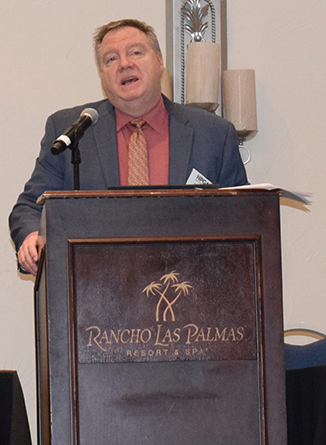Supply chain shocks prove need for changes
The search for stability in today’s world seems like an endless process.
Propane retailers are already accustomed to monitoring changing fundamentals of the industry that may affect daily operations: propane prices and production volumes, inventory and export levels, supply and demand scenarios.
But when COVID-19 inserted itself into our daily lives two years ago this month, the business environment experienced another layer of changes and challenges – impacting staffing, trucking, pricing and companies’ ability to obtain the materials and equipment needed to run a successful operation. Frustration set in.
The supply chain has been anything but stable, compelling the National Propane Gas Association (NPGA) to welcome a supply chain expert to its winter meetings in Palm Springs, California.
Supply chain ‘dysfunction’
Tom O’Brien, executive director of the Center for International Trade and Transportation, California State University, Long Beach, called COVID-19 a game-changer from a supply perspective and recounted the events that have led to many of today’s product shortages.

Tom O’Brien offers his insights about the supply chain at the National Propane Gas Association winter meetings in Palm Springs, California. (Photo by LP Gas staff)
Not only were container ships backed up at major U.S. ports like Long Beach, California, and Los Angeles, delaying the movement of products, but O’Brien noted the effects of a chassis shortage in the U.S. He called chassis the “unheralded linchpin of the supply chain.”
COVID created a “supply shock” for an already-turbulent system as well as a “demand-side shock on our side,” O’Brien explained. Stay-at-home mandates and federal stimulus funds fed a dramatic growth in online orders for various products. Uncertainty overcame the supply environment.
“What we’re experiencing is also a reflection of dysfunction in the supply chain,” issues that should have been addressed sooner than they were, he said.
O’Brien was positive and hopeful the current environment will bring about an emphasis on the freight and supply chain challenges, as well as the solutions. That may mean changes at the federal level.
“We have lacked a national transportation policy that recognizes the value of freight to the economy,” said O’Brien, who expressed hopefulness stemming from the new federal infrastructure law and a high level of engagement he’s witnessed across industry sectors.
He foresees policy measures that will require more domestic production of goods deemed critical and an interest by companies to increase their product inventory.
While propane retailers tell us supply chain issues are impacting their operations and creating obstacles that won’t go away overnight, positives in other areas are becoming more noticeable in the short term. Virus infection numbers are plummeting from their highs in January; events are returning (notably the NPGA’s Propane Expo to Nashville in April); and people are seeing one another face to face again. We also know propane is an essential energy source with capable leaders navigating a changing energy environment and strong-willed employees working on the front lines of the industry.
“One of the things I truly love is the people, and willingness and efforts to adapt and overcome,” says Tom Van Buren of Meritum Energy Holdings, treasurer of NPGA, comparing the leadership qualities he sees from the industry today to those exuded during his days in the U.S. Army.
An improved Buyers Guide
Our annual Buyers Guide in our March issue is a valuable resource that we hope adds stability to your propane operation.
We’re proud of this year’s guide because we reorganized the categories to make equipment and services easier to find, and we updated the design of the pages to accommodate the changes.
Over the past several guides, we’ve made efforts toward more consistent formatting and listing content. We’re also pulling data with new, stricter parameters that make the guide easier for you to use.
Emily Adkins, marketing and sales manager for the Buyers Guide, is the engine behind this popular LP Gas offering. We’re proud of the work she’s done to make this guide the best it’s been in its 78-year history.
















